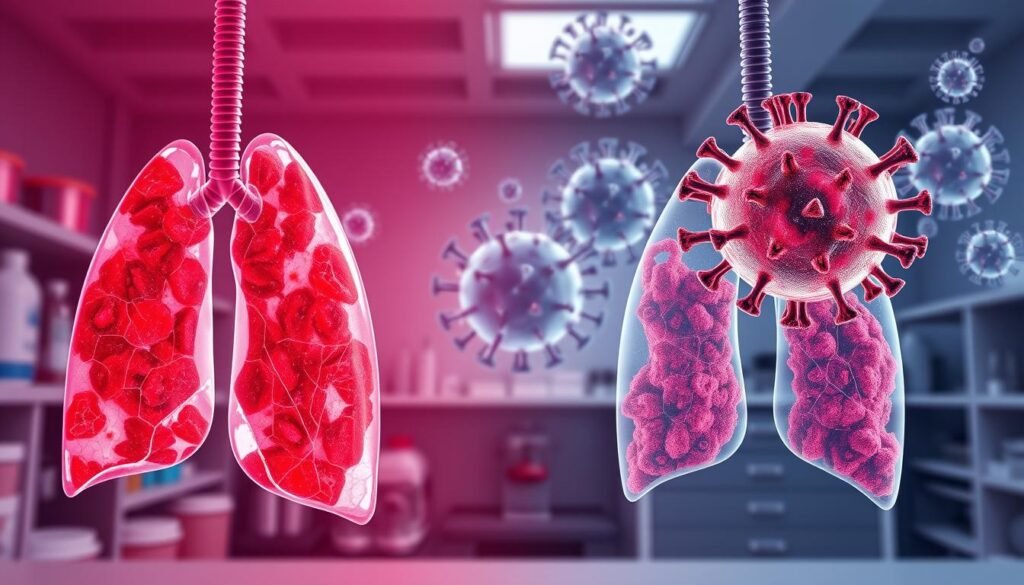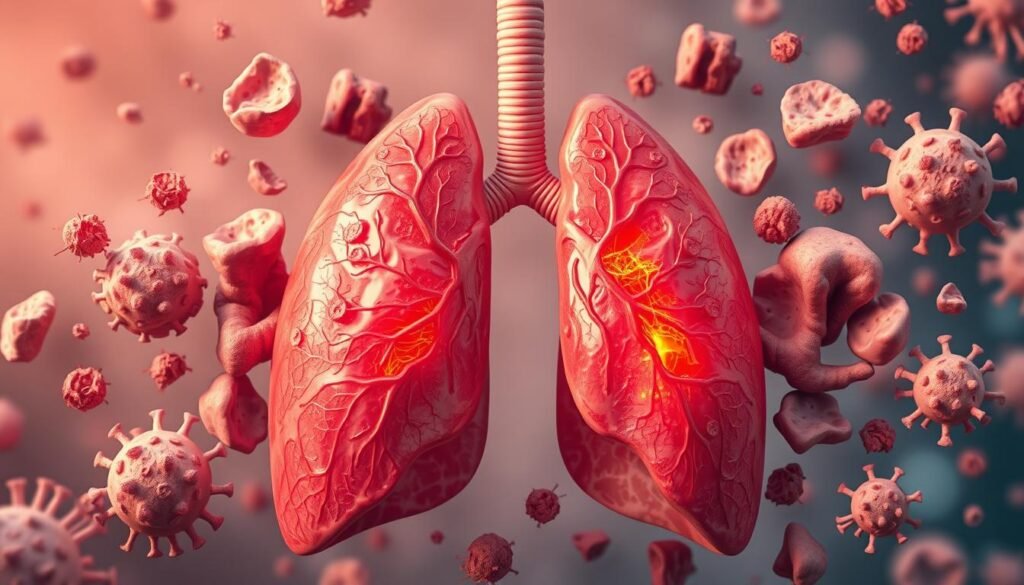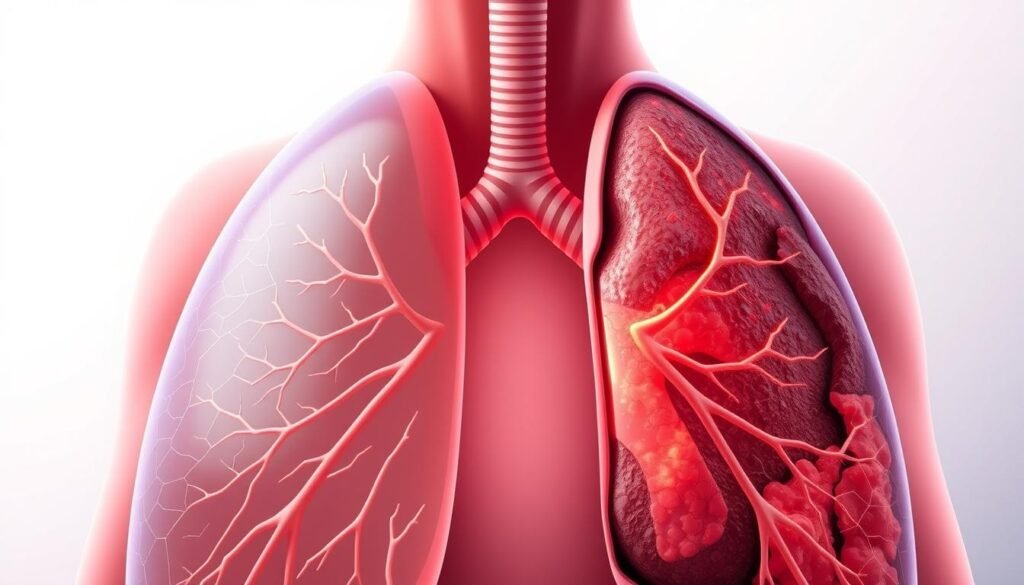Studies show more lung cancer cases in people who had COVID-19 than in those who didn’t. This raises concerns about COVID-19’s potential role in increasing lung cancer risk. The pandemic has also disturbed normal cancer care routines.
Research indicates lung cancer patients face worse outcomes if they catch COVID-19. They are more at risk due to their weak immune systems and inflammation. This might wake up sleeping cancer cells, boosting lung cancer rates. The virus adds problems to existing lung issues, highlighting the need to look at the pandemic’s effects on lung health.
This article delves into how COVID-19 might affect lung cancer, considering scientific and health perspectives. We’re learning how viruses like COVID-19 could speed up cancer. This knowledge helps shape cancer treatment in a world after the pandemic. It’s critical to figure out if COVID-19 can directly cause lung cancer. Or if it makes existing conditions worse. For more, see this study on COVID-19’s effect on diagnosing and treating lung cancer.
Key Takeaways
- COVID-19 has led to an increase in lung cancer incidence among infected patients.
- Patients with lung cancer face a heightened risk of severe outcomes from COVID-19.
- Severe immunosuppression and inflammatory responses play key roles in exacerbating lung cancer risks.
- Research is ongoing to uncover the long-term effects of COVID-19 on lung cancer treatments and outcomes.
- The pandemic disrupted cancer screening and care, potentially leading to increased mortality rates.
The Global Impact of COVID-19 on Health
The COVID-19 pandemic changed global health deeply. It put a lot of stress on healthcare systems everywhere. Hospitals had to focus on COVID-19 patients. This meant delays in other important services, affecting cancer care severely.
Lung cancer patients have really felt these effects. The mix of COVID-19 and cancer care brought up big concerns. For example, when to get a COVID-19 vaccine became tricky for these patients. Oncologists suggest getting vaccinated two to three weeks before starting cancer treatments like chemotherapy.
The stress on healthcare made things worse for lung cancer patients. Catching COVID-19 often left them with lasting symptoms like breathing troubles. Studies show more lung cancer cases in people who had COVID-19. This shows we can’t ignore lung cancer while fighting COVID-19.
With the pandemic, there’s been a new focus on studying the virus, SARS-CoV-2. This has affected how we collect samples in lung cancer research. As the virus changes, healthcare faces more problems. We must tackle both COVID-19 and cancer care together.
Understanding Lung Cancer: Basics and Statistics
Lung cancer is the top cause of cancer deaths worldwide. Every year, over 2 million new cases arise, showing the importance of learning about lung cancer. It mainly comes in two forms: non-small cell lung cancer and small-cell lung cancer.
Non-small cell lung cancer (NSCLC) makes up about 80% to 85% of all lung cancer cases. Adenocarcinoma, the most common type of NSCLC, is seen in roughly 40% of cases, often in non-smokers. Squamous cell carcinoma is about 30% of lung cancers and usually occurs in smokers. Large cell carcinoma, the least common, grows fast and can easily spread. It accounts for 10% to 15% of lung cancers.
Small-cell lung cancer represents 10% to 15% of cases and is mainly found in smokers. This type is known for being very aggressive, making early detection and treatment critical.
Smoking is the main cause of lung cancer, linked to 80% to 90% of cases. Even former smokers and people exposed to secondhand smoke are at increased risk. Other factors like radon, asbestos, and certain chemicals also play a role. Knowing these risks can help with prevention.
Getting diagnosed early greatly improves chances of survival for lung cancer patients. The American Cancer Society suggests yearly screenings for those 50 to 80 years old who have smoked. Looking out for symptoms like ongoing coughing, breathing trouble, and unexpected weight loss can lead to earlier help. For more information on lung cancer causes and risks, check this detailed source.
| Type of Lung Cancer | Percentage of Cases | Common Among |
|---|---|---|
| Non-small cell lung cancer | 80-85% | Smokers and non-smokers |
| Adenocarcinoma | 40% | Non-smokers |
| Squamous cell carcinoma | 30% | Smokers |
| Large cell carcinoma | 10-15% | Smokers |
| Small-cell lung cancer | 10-15% | Smokers |
Can COVID Cause Lung Cancer: The Current Research Landscape
Scientists are keenly looking into how COVID-19 and lung cancer might be linked. They’re exploring if the virus could affect cancer’s growth. This research is crucial as we worry about COVID-19’s long-term effects on people with cancer.
Links Between COVID-19 Infection and Lung Cancer Cases
Getting COVID-19 is extra risky for those already facing lung cancer. These patients are more likely to face tough challenges if infected. The virus’s attack on the immune system can make things worse, leading to serious lung problems. A key worry is whether COVID-19 might wake up sleeping cancer cells, raising the chances of lung cancer for those infected.
The Role of Inflammation in Lung Cancer Development
Inflammation is key in how cancer gets worse, and COVID-19 might play a role in this. This connection could make existing cancers grow faster or even start new cancers. Early studies hint that the virus’s inflammation could help tumors spread. Knowing this helps scientists look for ways to treat inflammation. This could help prevent lung cancer in people who have had COVID-19.

COVID-19 and Pre-existing Lung Conditions
Having a pre-existing lung condition affects how one fights COVID-19. People with chronic lung diseases face a higher risk when they get COVID-19. This is because they already have health issues. A study of over 8 million people showed some concerning results. It found that 0.2% were hospitalized due to COVID-19. The number was even higher for those with lung problems.
When someone has a lung disease, dealing with COVID-19 becomes harder. For example, COPD patients have a 1.54 times higher chance of being hospitalized. And for lung cancer patients, the risk is even bigger at 2.24 times. This information shows us that lung problems can make COVID-19 more deadly.
It’s crucial for patients to manage their lung conditions well, especially when faced with COVID-19. They should not skip their doctor visits or medicines. By taking good care of their health, they can better handle the virus. This approach is necessary to keep themselves safe from severe COVID-19 complications.

Doctors advise checks for those with breathing issues. This step helps in planning early treatments. Such early action is key to improving lung health after a COVID-19 infection.
Long-term Effects of COVID-19 on Lung Health
Long-term effects of COVID-19 have raised big concerns about lung health in recovered patients. These survivors often deal with lasting symptoms. These symptoms lead to complications that can disrupt daily activities and reduce quality of life. Studies have found that these complications can include lasting lung damage from COVID-19. This damage needs careful attention and monitoring.
Exploring COVID-19’s Respiratory Complications
Research has found that COVID-19 can have a big impact on lung health even after recovery. For example, a study that followed SARS-CoV patients for 15 years found long-term lung issues. These issues might also happen to people who recovered from COVID-19. Also, a study on MERS-CoV survivors showed that about a third had signs of lung scarring. This highlights a long-term risk that needs more research.
There is a notable range in lung cancer rates among people with lung scarring, from 2.7% to 48%. The link between COVID-19 and lung health changes is under investigation. It focuses on how certain inflammation-causing substances might play a role in both COVID-19’s severe inflammation and lung cancer. While it’s not confirmed if COVID-19 directly causes lung cancer, understanding this link is very important.
Post-COVID-19 respiratory symptoms vary widely, affecting 5% to 40% of those with long COVID. Delays in lung cancer screenings due to these symptoms have been noted. This delay calls for healthcare providers to act quickly. Currently, there’s no clear guidance on how often long COVID patients should get CT scans. There’s a strong need for a plan to check for lung cancer risks in these patients.

The Connection Between Smoking and COVID-19 Lung Damage
Smoking and COVID-19 together create big worries for everyone’s health. Studies show that smoking makes COVID-19’s lung damage worse. A recent study found about 40.54% of its patients were smokers. These smokers were more likely to face tough battles against COVID-19. The study also showed more men smoked than women, pointing to gender differences in smoking risks.
It’s key to understand how quitting smoking affects lung health. Smokers tend to have more health issues like high blood pressure and diabetes. These problems increase their risk of having serious COVID-19 complications. For example, people who had severe lung issues before were more likely to get lung cancer later. The study found that 32 out of 59 lung cancer cases were in patients with a past severe lung disease.
The average age of smokers in the study was 52, close to the 53 years for non-smokers. The time spent in the hospital was about the same for both groups. Yet, those who smoked for a long time were more prone to developing lung cancer. This is linked to chronic lung diseases, which are common in smokers. The study showed a strong link between these lung diseases and a higher lung cancer risk.
The rate of lung cancer diagnosis jumped within three months after a COVID-19 infection, compared to six months after. This emphasizes the need for programs to help people stop smoking. Such programs can improve lung health. They can also reduce the chance of getting lung cancer and ease the impact of COVID-19. Working together to help people quit smoking can lead to better health for those affected by the pandemic.
| Category | Smokers | Non-Smokers |
|---|---|---|
| Percentage of Patients | 40.54% | 59.46% |
| Median Age | 52 years | 53 years |
| Female Smokers Percentage | 28.89% | N/A |
| Hospital Stay (Median Days) | 6 days | 6 days |
| Hypertension Prevalence | 26.13% | 26.13% |
| Diabetes Prevalence | 22.52% | 22.52% |
| Chronic Kidney Disease Prevalence | 3.60% | 3.60% |
| Odds Ratio for Lung Cancer Development (COPD) | 6.37 | N/A |
COVID-19 Screening for Lung Cancer: An Emerging Concern
The COVID-19 pandemic has hit healthcare systems hard, sparking big COVID-19 screening challenges for lung cancer. Many resources are now focused on COVID-19, leading patients to put off screening. This postponement in lung cancer screening during COVID-19 could mean more people are diagnosed late.
While we battle the pandemic, catching lung cancer early is still critical. There’s been a big drop in patients getting screened on time. In England, there was a 24.1% decrease in checks for cancer signs between 2019 and 2020. When the first lockdown hit, chest X-rays used to find lung cancer fell by 93% in some places.
Viral infections like COVID-19 can cause long-term inflammation, which ups the risk for lung cancer. Monitoring Long COVID patients shows us there may be a bigger cancer risk later on. Low-dose CT scans are key for catching cancer early, helping save lives.
Setting up screenings at places like Neumark Lung and Chest Surgery Centre helps find cancer early. With the latest treatments and surgeries, we can fight lung cancer better. It’s crucial to keep screening to protect patients from late diagnosis in these tough times.
For more info, check out the analysis here on these important issues.
Post-COVID Syndrome: Understanding Its Implications for Lung Cancer
People who have had COVID-19 might face ongoing lung health challenges. This is especially true when considering lung cancer. Long COVID can cause lingering breathing problems. This might make existing health issues worse. Learning about these effects is key to helping those at higher risk.
Assessing the Risks for Vulnerable Populations
The elderly and those already sick are at greater lung health risk after COVID-19. The world saw over 1.8 million COVID-19 cases after it became a pandemic on March 11, 2020. In particular, the United States felt this impact deeply. People over 60 are especially likely to suffer from severe symptoms. This fact highlights the importance of targeted health care approaches.
Lung cancer patients are more at risk of getting COVID-19, leading to worse outcomes. A study from China found that individuals with cancer, including lung cancer, have a higher chance of facing serious COVID-19 issues. It emphasizes the need for special care for those dealing with lung cancer and post-COVID syndrome.
Research connecting allergies with lung cancer offers interesting insights. There’s evidence that allergic rhinitis may actually reduce the risk of lung cancer. For more details, check out the relationship between allergies and lung cancer. Understanding these relationships could help in finding better ways to treat and prevent lung cancer.
As we deal with COVID-19’s aftereffects, we must focus on those at higher risk of lung cancer. It’s critical that health professionals create plans to shield these vulnerable groups. Such efforts ensure everyone receives the support and care they need.
Conclusion
The global health crisis has shown us tough challenges. It links COVID-19 with lung cancer issues. A look at how the virus may worsen lung cancer is urgent.
Patients with past COVID-19 cases might face higher risks. This is especially true for those already fighting lung problems or cancer. We need more studies on COVID-19’s effect on lung cancer.
The healthcare world is changing fast. Research now should dig into how COVID-19 relates to lung cancer. Working together, researchers and doctors must study the virus’s long-term effects on lungs. Policy changes should help find and prevent lung cancer early, especially in those at high risk.
To fight lung cancer in the COVID-19 era, we must be proactive. This means keeping a close eye on patients, tweaking treatments, and working together across disciplines. New policies should reflect these needs. They could improve life for those with lung cancer and reduce COVID-19’s negative impacts.